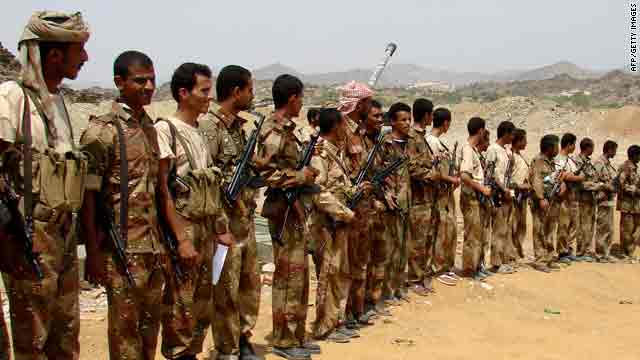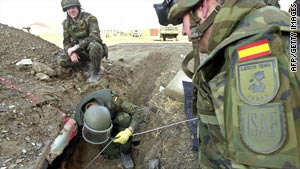Major offensive on Afghan Taliban
BBC 15:22 GMT, Saturday, 13 February 2010
Nato-led forces say they are making good progress hours after launching the biggest offensive in Afghanistan since the overthrow of the Taliban in 2001.
There were clashes as more than 15,000 US, UK and Afghan troops swept into the Helmand districts of Marjah and Nad Ali in a bid to secure government control.
An Afghan commander said 20 militants had been killed. Two Nato soldiers, one of which was British, have also died.
A Taliban commander reportedly said his men were retreating to spare civilians.
Operation Moshtarak - which means "together" in the local Dari language - is being led by 4,000 US Marines, supported by 4,000 British troops, with Canadians, Danes and Estonians.
'Heavily booby-trapped'
The BBC's Frank Gardner, with Nato forces at Kandahar airbase, says the test of the operation's success will not be on the battlefield.
 | AT THE SCENE Ian Pannell
BBC News, Nad Ali It's been a very successful day for British forces. They were able to move into several key villages and establish a foothold. Broadly speaking, they met little resistance. There was sporadic gunfire. One RPG was fired over the location where we are based. It's fair to say that the Taliban decided to move out of the district. Many civilians have also left, and the challenge in the coming days and weeks is to persuade them to come back, to establish meaningful security and then allow meaningful governance to take place. What will make a difference is if there is meaningful security established and if the local people feel confident enough to place their faith in local security forces. This is an operation that has only just begun and it will take weeks and months before we know how successful it has been. |
It all depends on whether the coalition can hold the ground and bring lasting security and good governance to the population of central Helmand.
A spokesman for Nato's Isaf force confirmed to the BBC that two soldiers had been killed in Operation Moshtarak.
British forces said a soldier from the 1st Battalion Grenadier Guards had been killed by an explosion in Nad Ali.
A second Nato soldier was killed by small-arms fire.
Three US soldiers were also killed by an IED, Nato said, although it is not clear whether they were part of Operation Moshtarak.
Mohammad Zazai, commander of Afghan troops in the operation, said: "So far, we have killed 20 armed opposition fighters. Eleven others have been detained." The casualties and captures were in separate incidents.
Troops have been advancing carefully, picking their way through poppy fields, trying not to set off Taliban bombs.
A canal bridge into Marjah was so rigged with explosives that US Marines had to erect temporary crossings to reach the town, reports the Associated Press.
Helmand Governor Gulab Mangal told a news conference the Taliban had "heavily booby-trapped the area".
Marjah resident Abdul Wahaab told AFP by telephone as he and his family left the town: "We were sleeping when all of a sudden we heard this horrible noise - it was helicopters bringing in soldiers.
"As we were crossing the village we saw US and Afghan soldiers on the junctions. There were lots of them."
Afghan President Hamid Karzai, who approved Operation Moshtarak, warned troops to avoid civilian casualties, and called on Taliban fighters to lay down their weapons.
Nato says Marjah is home to the biggest community under insurgent control in the south.
'On the hop'
It was estimated there were between 400 and 1,000 militants based there before Operation Moshtarak was launched.
Marjah has also long been regarded as a linchpin of the lucrative network for smuggling opium - the raw ingredient used to make heroin - harvested from Helmand's poppy fields.
Nato Commander Maj Gen Nick Carter told the BBC that "it would appear that we've caught the insurgents on the hop".
Later at a Ministry of Defence briefing in London, Maj Gen Gordon Messenger said the UK force of more than 1,000 troops in the initial Marjah operation had secured its "key objectives" at the start of Operation Moshtarak.
He said: "There's no complacency - everyone understands this is the easy bit. The hard bit is what comes next in reassuring the public.
"This is all about winning the allegiance of the population. The allegiance is not won in a day, it must be won over time."
The offensive began with waves of helicopters ferrying US Marines into Marjah in the early hours of Saturday.
British troops then flew into Nad Ali district, to the north, followed by tanks and combat units.
Jets and helicopters fired missiles at Taliban positions.
The BBC's Ian Pannell in Nad Ali says the vast majority of villagers seem to have left the area to avoid getting caught in crossfire between the Taliban and Nato troops.
Mullah Mohammed - a Taliban commander in Marjah - told ABC News that his men were pulling back to spare any civilian casualties.
"We found civilians in massive danger so we decided to go backward just to save villagers' lives," he said. His claim cannot be verified.
Nato had distributed leaflets in the Marjah area warning of the planned offensive in a bid to limit civilian casualties.
It is the first major offensive since US President Barack Obama ordered a "surge" of 30,000 extra troops to Afghanistan in December.
More than 1,900 Afghan police will provide support after the initial military operations end, and a large team of Afghan administrators has been assembled.
The operation is part of an effort to secure a 320-km (200-mile) horseshoe-shaped string of towns that runs along the Helmand River, through Kandahar and on to the Pakistani border.
The area holds 85% of the population of Kandahar and Helmand.

 Video: Yemen declares cease fire
Video: Yemen declares cease fire 




